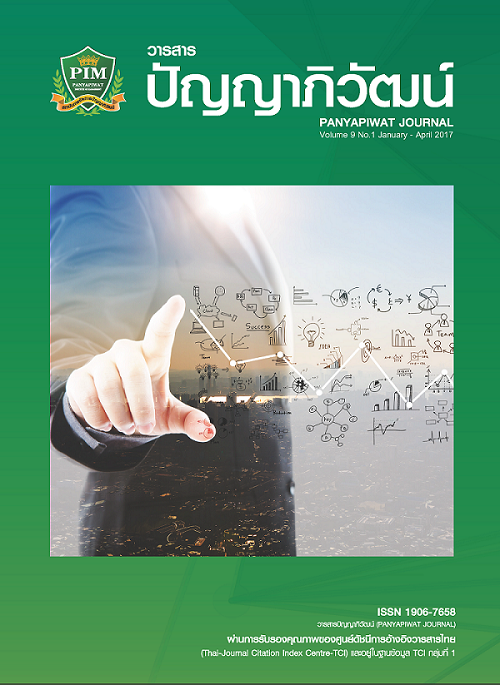ขนาดผลกระทบ: ผลลัพธ์ที่สำคัญที่สุดของการทดสอบสมมติฐาน
Main Article Content
บทคัดย่อ
ในการวิจัยเชิงประจักษ์ด้านธุรกิจ เศรษฐกิจ และด้านอื่นๆ ของสังคมศาสตร์ ผลลัพธ์ที่สำคัญที่สุดของการทดสอบสมมติฐานไม่ใช่ค่า p-value แต่เป็นขนาดผลกระทบ เพราะว่าขนาดผลกระทบทำให้นักวิจัยสามารถสื่อสารการมีนัยสำคัญในทางปฏิบัติของผลการวิจัยและสามารถอธิบายเกี่ยวกับผลกระทบที่จะเกิดขึ้นในโลกแห่งความเป็นจริง ขนาดผลกระทบเป็นสารสนเทศที่มีความสำคัญสำหรับผู้ที่จะนำผลการวิจัยไปสู่การปฏิบัติซึ่งต้องการทราบว่าผลกระทบของตัวแปรอิสระมากกว่าศูนย์หรือไม่และผลกระทบมีขนาดมากเพียงใด การทดสอบนัยสำคัญทางสถิติไม่สามารถประเมินความสำคัญในทางปฏิบัติของผลการวิจัย และไม่ได้บอกสิ่งที่ผู้นำผลการวิจัยไปปฏิบัติต้องการจะรู้ การทดสอบนัยสำคัญทางสถิติจึงเป็นการวัดและรายงานผลการทดสอบสมมติฐานที่มีความหมายในทางทฤษฎีเท่านั้น ดังนั้น เมื่อใดก็ตามที่มีการทดสอบสมมติฐาน นักวิจัยควรวัดและรายงานขนาดผลกระทบในส่วนที่เป็นรายงานผลการวิจัยด้วย ไม่ใช่รายงานเฉพาะค่า p-value เท่านั้น
Effect sizes, not p-value, are the most important products of hypothesis testing in the empirical studies of business, economics, and other branches of social science because effect sizes allow researchers to communicate the practical significance of the research results and describe the observed effects. Effect sizes are the important information for practitioners who implement the research results and want to know whether each independent variable has an effect greater than zero and how big the effect is. Test of statistical significance cannot evaluate the practical importance of research results and cannot inform what practitioners want to know. Test of statistical significance only measure and report the theoretically meaningful results of hypothesis testing. Therefore, whenever hypothesis testing is performed, not only p-value should be measured and reported in the research results, but also the effect sizes.
Article Details
“ข้าพเจ้าและผู้เขียนร่วม (ถ้ามี) ขอรับรองว่า บทความที่เสนอมานี้ยังไม่เคยได้รับการตีพิมพ์และไม่ได้อยู่ระหว่างกระบวนการพิจารณาลงตีพิมพ์ในวารสารหรือแหล่งเผยแพร่อื่นใด ข้าพเจ้าและผู้เขียนร่วมยอมรับหลักเกณฑ์การพิจารณาต้นฉบับ ทั้งยินยอมให้กองบรรณาธิการมีสิทธิ์พิจารณาและตรวจแก้ต้นฉบับได้ตามที่เห็นสมควร พร้อมนี้ขอมอบลิขสิทธิ์บทความที่ได้รับการตีพิมพ์ให้แก่สถาบันการจัดการปัญญาภิวัฒน์หากมีการฟ้องร้องเรื่องการละเมิดลิขสิทธิ์เกี่ยวกับภาพ กราฟ ข้อความส่วนใดส่วนหนึ่งและ/หรือข้อคิดเห็นที่ปรากฏในบทความข้าพเจ้าและผู้เขียนร่วมยินยอมรับผิดชอบแต่เพียงฝ่ายเดียว”
เอกสารอ้างอิง
American Educational Research Association. (2006). Standards for reporting on empirical social American science research in AERA publications. Educational Researcher, 35(6), 33-40.
American Psychological Association. (2001). Publication manual of the American Psychological Association (5th ed.). Washington, DC: Author.
American Psychological Association. (2010). Publication manual of the American Psychological Association (6th ed.).Washington, DC: Author.
Berenson, M. L., Levine, D. M. & Krehbiel, T. C. (2012). Basic business statistics: concepts and applications (12th ed.). USA: Prentice Hall.
Cohen, J. (1988). Statistical power analysis for the behavioral sciences (2nd ed.). Hillsdale, NJ: Lawrence Erlbaum.
Cohen, J. (1990). Things I have learned (so far). American psychologist, 45, 1304-1312.
Cohen, J. (1994). The earth is round (p<.05). American psychologist, 49,997-1003.
Ellis, P. D. (2010). The essential guide to effect sizes: statistical power, meta-analysis, and the interpretation of research results. United Kingdom: Cambridge University Press.
Ferguson, C. J. (2009). An effect size primer: a guide for clinicians and researchers. Professional Psychology:Research and Practice, 40(5), 532-538.
Field, A. (2009). Discovering statistics using SPSS (2nd ed.). London: Sage Publication.
Fritz, C. O, Morris, P. E. & Richler, J. J. (2012). Effect size estimates: current use, calculations, and interpretation.Journal of Experimental Psychology: General, 141(1), 2-18.
Gliner, J. A., Leech, N. L. & Morgan, G. A. (2002). Problems with null hypothesis significance testing (NHST): What do the textbooks say? The Journal of Experimental Education, 71(1), 83-92.
Hentschke, H. & Stuttgen, M. C. (2011). Computation of measures of effect size for neuroscience data sets. European Journal of Neuroscience, 34, 1887-1894.
Kirk, R. E. (1996). Practical significance: a concept whose time has come.Educational and Psycho-logical Measurement, 56(5), 746-759.
Kline, R. B. (2004). Beyond significance testing: reforming data analysis methods in behavioral research. Washington DC: American Psychological Association.
Kotrlik, J. W. & Wiliams, H. A. (2003). The incorporation of effect size in information technology, learning, and performance research. Information Technology, Learning, and Performance Journal,21(1), 1-7.
Lakens, D. (2013).Calculating and reporting effect sizes to facilitate cumulative science: a practical primer for t-tests and ANOVAs. Frontiers in Psychology, 4, 1-12.
Levine, T. R. & Hullett, C. R. (2002). Eta squared, partial eta squared, and misreporting of effect size in communication research. Human Communication Research, 28(4), 612-625.
McMillan, J. H., Lawson, S., Lewis, K. & Snyder, A. (2002). Reporting effect size: the road less traveled. Paper presented at the 2002 annual meeting of the American Educational Research Association, New Orleans.
Olejnik, S. & Algina, J. (2003). Generalized eta and omega squared statistics: measures of effect size for some common research designs. Psychological Methods, 8(4), 434-447.
Privitera, G. J. (2015). Statistics for the behavioral sciences (2nd ed.). USA: Sage Publication.
Richardson, J. T. (1996). Measures of effect size. Behavioral Research Methods, Instruments & Computers, 28, 12-22.
Rosenthal, R. (1994). Parametric measures of effect size. In H. Cooper & L. V. Hedges (Eds.), The handbook for research synthesis (pp. 231–244). NY: Russell Sage Foundation.
Rosnow, R. L. & Rosenthal, R. (2003). Effect sizes for experimenting psychologists. Canadian Journal of Experimental Psychology, 57(3), 221-237.
Snyder, P. & Lawson, S. (1993). Evaluating results using corrected and uncorrected effect size estimates. Journal of Experimental Education, 61(4), 334-349.
Tomczak, M. & Tomczak, E. (2014). The need to report effect size estimates revisited: an overview of some recommended measures of effect size. TRENDS in Sport Sciences, 1(21), 19-25.
Vacha-Haase, T. & Thompson, B. (2004). How to estimate and interpret various effect sizes. Journal of Counseling Psychology, 51(4), 473-481.


